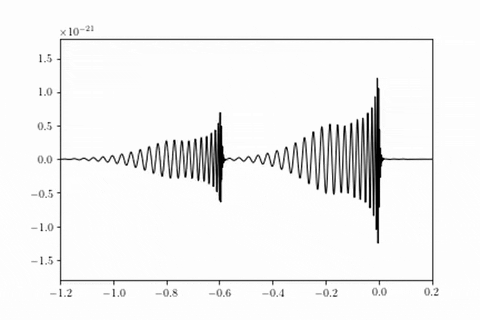https://phys.org/news/2020-12-ripples-space-time-clues-components-universe.html
Ripples in space-time could provide clues to missing components of the universe

There's something a little off about our theory of the universe. Almost everything fits, but there's a fly in the cosmic ointment, a particle of sand in the infinite sandwich. Some scientists think the culprit might be gravity—and that subtle ripples in the fabric of space-time could help us find the missing piece.
A new paper co-authored by a University of Chicago scientist lays out how this might work. Published Dec. 21 in Physical Review D, the method depends on finding such ripples that have been bent by traveling through supermassive black holes or large galaxies on their way to Earth.
The trouble is that something is making the universe not only expand, but expand faster and faster over time—and no one knows what it is. (The search for the exact rate is an ongoing debate in cosmology).
Scientists have proposed all kinds of theories for what the missing piece might be. "Many of these rely on changing the way gravity works over large scales," said paper co-author Jose María Ezquiaga, a NASA Einstein postdoctoral fellow in the Kavli Institute for Cosmological Physics at the UChicago. "So gravitational waves are the perfect messenger to see these possible modifications of gravity, if they exist."
more at link.....
the paper:
https://journals.aps.org/prd/abstract/10.1103/PhysRevD.102.124048
Gravitational wave lensing beyond general relativity: Birefringence, echoes, and shadows:
ABSTRACT
Gravitational waves (GW), as light, are gravitationally lensed by intervening matter, deflecting their trajectories, delaying their arrival and occasionally producing multiple images. In theories beyond general relativity, new gravitational degrees of freedom add an extra layer of complexity and richness to GW lensing. We develop a formalism to compute GW propagation beyond general relativity over general space-times, including kinetic interactions with new fields. Our framework relies on identifying the dynamical propagation eigenstates (linear combinations of the metric and additional fields) at leading order in a short-wave expansion. We determine these eigenstates and the conditions under which they acquire a different propagation speed around a lens. Differences in speed between eigenstates cause birefringence phenomena, including time delays between the metric polarizations (orthogonal superpositions of h+, h×) observable without an electromagnetic counterpart. In particular, GW echoes are produced when the accumulated delay is larger than the signal’s duration, while shorter time delays produce a scrambling of the waveform. We also describe the formation of GW shadows as nonpropagating metric components are sourced by the background of the additional fields around the lens. As an example, we apply our methodology to quartic Horndeski theories with Vainshtein screening and show that birefringence effects probe a region of the parameter space complementary to the constraints from the multimessenger event GW170817. In the future, identified strongly lensed GWs and binary black holes merging near dense environments, such as active galactic nuclei, will fulfill the potential of these novel tests of gravity.
Ripples in space-time could provide clues to missing components of the universe

There's something a little off about our theory of the universe. Almost everything fits, but there's a fly in the cosmic ointment, a particle of sand in the infinite sandwich. Some scientists think the culprit might be gravity—and that subtle ripples in the fabric of space-time could help us find the missing piece.
A new paper co-authored by a University of Chicago scientist lays out how this might work. Published Dec. 21 in Physical Review D, the method depends on finding such ripples that have been bent by traveling through supermassive black holes or large galaxies on their way to Earth.
The trouble is that something is making the universe not only expand, but expand faster and faster over time—and no one knows what it is. (The search for the exact rate is an ongoing debate in cosmology).
Scientists have proposed all kinds of theories for what the missing piece might be. "Many of these rely on changing the way gravity works over large scales," said paper co-author Jose María Ezquiaga, a NASA Einstein postdoctoral fellow in the Kavli Institute for Cosmological Physics at the UChicago. "So gravitational waves are the perfect messenger to see these possible modifications of gravity, if they exist."
more at link.....
the paper:
https://journals.aps.org/prd/abstract/10.1103/PhysRevD.102.124048
Gravitational wave lensing beyond general relativity: Birefringence, echoes, and shadows:
ABSTRACT
Gravitational waves (GW), as light, are gravitationally lensed by intervening matter, deflecting their trajectories, delaying their arrival and occasionally producing multiple images. In theories beyond general relativity, new gravitational degrees of freedom add an extra layer of complexity and richness to GW lensing. We develop a formalism to compute GW propagation beyond general relativity over general space-times, including kinetic interactions with new fields. Our framework relies on identifying the dynamical propagation eigenstates (linear combinations of the metric and additional fields) at leading order in a short-wave expansion. We determine these eigenstates and the conditions under which they acquire a different propagation speed around a lens. Differences in speed between eigenstates cause birefringence phenomena, including time delays between the metric polarizations (orthogonal superpositions of h+, h×) observable without an electromagnetic counterpart. In particular, GW echoes are produced when the accumulated delay is larger than the signal’s duration, while shorter time delays produce a scrambling of the waveform. We also describe the formation of GW shadows as nonpropagating metric components are sourced by the background of the additional fields around the lens. As an example, we apply our methodology to quartic Horndeski theories with Vainshtein screening and show that birefringence effects probe a region of the parameter space complementary to the constraints from the multimessenger event GW170817. In the future, identified strongly lensed GWs and binary black holes merging near dense environments, such as active galactic nuclei, will fulfill the potential of these novel tests of gravity.
